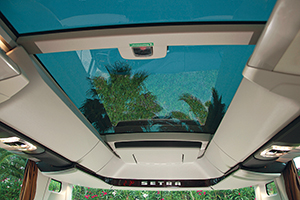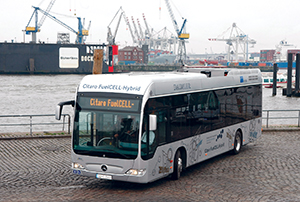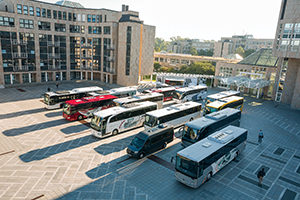
By Doug Jack
Of all the trade associations representing vehicle manufacturers in Europe, Germany’s Verband der Automobilindustrie (VDA) is in a league of its own. In years ending in an odd number, VDA organizes a major international car exhibition in Frankfurt. In even-numbered years, it organizes the international commercial vehicle exhibition (IAA) in the vast fairground in the northern Germany city of Hannover.
—————————————————————————————————————————————
YOU MIGHT ALSO LIKE:
- Transports Publics Exhibition: No diesel please; we are French
- Solaris had a record year
- Cummins grows in Europe
- Europe launches the ZeEUS project
—————————————————————————————————————————————
Both are the largest international exhibitions of their kind, certainly in Europe.
IAA will run from September 25 to October 2, occupying around a dozen halls with adjacent outside display areas and parallel conferences. It is well worth a visit, but if you book late, you might have to find a hotel up to 40-50 miles away.
VDA held an International Press Workshop in June 26, in Frankfurt, as part of the run-up to the IAA exhibition. A number of very senior executives, including the CEO’s of MAN and Scania, the heads of Mercedes-Benz Trucks and Daimler Buses, gave short presentations.
Many were trying to influence politicians who seem to think that the answer to road congestion is to shift all freight over to rail.

Get the word out
Unfortunately, few politicians have been brave enough to come to the event, therefore VDA relies on the media to put messages across — in addition to its own influential lobbying and that of the powerful domestic industry.
Call to the media
The audience consisted of journalists from the national and international business and financial press, and trade journalists from several countries around the world (as far away as China and Japan). VDA President Matthias Wissmann asked the media to bring the various political arguments being put forward by the speakers to the attention of their readers.

An attractive companion
Hartmut Schick, head of Daimler Buses and ever the diplomat, delivered a paper entitled Attractive Companion and CO2 Champion. The Bus in Short-and Long-Distance Transport. He opened by saying he wanted to show the bus from a different angle, describing the bus as an attractive companion.
“When is someone considered to be attractive?” he asked. “The answer is when someone evokes a kind of spontaneous liking or positive attitude, for instance acting with consideration, having a pleasant appearance and manners, and creating a sense of well-being in others.”
His attribute of attractiveness fully applies to the bus. Buses give consideration to the environment as well as to people when it comes to the topic of safety, particularly when compared with other modes of transportation.
Positive appearance is characterized by innovative bus design. The well-being of passengers is ensured by the extraordinarily high level of comfort and air conditioning in state-of-the-art buses.

Focus on CO2
Schick said that the latest Euro VI emission standards had reached the validation limit. The focus was now on reduction of CO2 emissions. Euro VI can read EPA 13, because the two standards are achieving the same results, but with slightly different test cycles. Indeed, some of the latest generation Daimler diesel engines made in Europe were developed in very close collaboration with Detroit Diesel.
Schick said that the bus will play a key role in transporting people in an environmentally friendly manner. Compared to other modes of transport, according to the German Federal Environmental Authority, coaches generated the lowest CO2 emissions per passenger per mile of any form of transport. In contrast, the two worst offenders were aircraft and private cars.
Daimler was quick to put Euro VI buses and coaches into service in Europe, and had found that the latest generation of engines was achieving savings in fuel consumption of up to 8.5 percent.

No hybrids for now
Daimler is not currently offering a hybrid bus, saying it offers little advantage in fuel consumption compared with a standard diesel, and therefore not economically viable.
That decision has set Daimler on a direct collision course with Volvo, which is the market leader in hybrid buses in Europe; and will only offer hybrid drivelines in its full low-floor Euro VI city buses.
“However, I am absolutely certain that sooner or later this will change, and when the time comes we will not come out with prototype solutions,” Schick said. “We are working intensively on an economically justifiable, mature and highly modular concept. I am convinced that, in the long term, the future belongs to the fuel cell. Through the Group-wide development of alternative powertrain technologies, we will be able to present an economical solution.”
Daimler Buses is currently working on the next generation city bus platform, which will be able to take diesel, gas, hybrid, fuel cell and all-electric powertrains.
Continuing with the theme of attractiveness, Schick referred to the outstanding safety record of buses. According to Germany’s Federal Statistical Office, the bus had the lowest frequency of traffic accident involving personal injuries, with just 1.5 percent of the total in 2012.
He said while well-trained bus drivers are of primary importance, safety technologies are also making a major contribution. He listed the many safety features on Daimler buses, many of them introduced before any legislative requirement.
Buses and coaches are also attractive because of their design. On top-end luxury coaches, he described the comfort as “awesome interiors reminiscent of first-class in a jet liner.”
Attitudes toward city bus travel have also changed tremendously over the last 30 years —and for the better.
Passengers now see city buses in a much more favorable light, using keywords like “reliable,” “comfort” and “communal.” In contrast, other forms of transport have slipped backwards in perception.

Germany cedes to intercity buses
Until 2012, intercity express travel by coach in Germany was severely restricted in order to protect the rail system. Services started to be liberalized in 2012 and the number of permits for long distance coach services in Germany nearly tripled between 2012 and 2013.
Coach services were popular, because they were the most inexpensive mode of long-distance transport in Germany. Research had shown that almost every third person was interested in taking a long distance coach and half had already used one.
This is encouraging for the manufacturers, because companies are investing in new express coaches. It is in fact a new market segment in Germany.
Schick concluded his presentation by referring to Bus Rapid Transit (BRT) as an innovative mobility solution, which provided for separate bus lanes where special vehicles could drive with a higher frequency. They were an incentive to switch from individual transport to public transport, offered rapid services, particularly in congested urban areas, and could be installed without extensive civil engineering measures.
Mercedes-Benz has experience with BRT operations in several countries in South America, and is the main supplier to the largest BRT system in Europe, that of IETT in Istanbul.
Schick referred to the comparative cost of infrastructure investments, taking as an example a recent study in Bangkok, Thailand. For the same capital expenditure, the city could install 4.5 miles of subway, 9 miles of elevated railroad, 25 miles of light rail system, or 265 miles of BRT.
“This makes BRT the ideal solution for public transport in rapidly expanding cities, where numbers continue to rise due to the growing population and increasing urbanization,” he said.
Schick said the bus is definitively an attractive companion; environmentally friendly, safe, comfortable and an important player when it comes to mobility solutions of the future. This was certainly a presentation that caught the attention of the audience and provoked a lot of thought.
Doug Jack is with Transport Resources in the United Kingdom.
